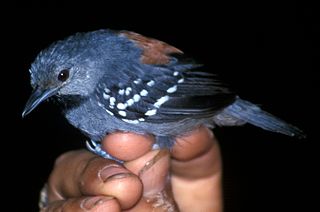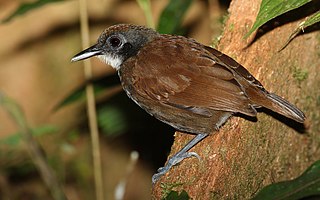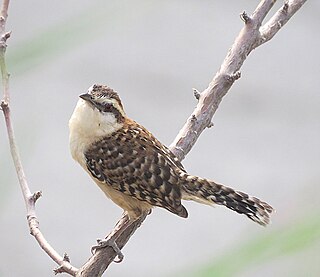
The Iago sparrow, also known as the Cape Verde or rufous-backed sparrow, is a passerine bird of the sparrow family Passeridae. It is endemic to the Cape Verde archipelago, in the eastern Atlantic Ocean near western Africa. Females and young birds have brown plumage with black marks above, and a dull grey underside, and are distinguished from other species of sparrow by their large, distinct supercilium. Males have a brighter underside and bold black and chestnut stripes on their head. At 12.5–13 centimetres (4.9–5.1 in) long, it is a smaller sparrow. This bird's vocalisations are mostly variations on its chirp, which differ somewhat between males and females.

The rufous-crowned sparrow is a small American sparrow. This passerine is primarily found across the Southwestern United States and much of the interior of Mexico, south to the transverse mountain range, and to the Pacific coast to the southwest of the transverse range. Its distribution is patchy, with populations often being isolated from each other. Twelve subspecies are generally recognized, though up to eighteen have been suggested. This bird has a brown back with darker streaks and gray underparts. The crown is rufous, and the face and supercilium are gray with a brown or rufous streak extending from each eye and a thick black malar streak.

The chestnut sparrow is a species of passerine bird in the sparrow family Passeridae. It is the smallest member of the sparrow family, at about 11 cm (4.3 in) long. The breeding male has deep chestnut plumage and the female and juvenile are coloured a duller grey with some chestnut markings. Like its closest relatives in the genus Passer, the Arabian golden sparrow and the Sudan golden sparrow, it is gregarious and found in arid areas. Ranging through the east of Africa from Darfur in Sudan to Tanzania, it is found in dry savanna, papyrus swamps, and near human habitation. Adults and juveniles both feed mostly on grass seeds, and fly in flocks, often with other species of birds, to find food. It nests in trees, building its own domed nests, and also usurping the more elaborate nests of weavers.

The Kenya sparrow, also known as the Kenya rufous sparrow, is a sparrow found in Kenya and Tanzania. It tends to be found in dry wooded savannah and agricultural areas. Some authorities have lumped the great sparrow (P. motitensis), the Kenya sparrow, and the Socotra sparrow (P. insularis) into P. motitensis following Dowsett and Forbes-Watson (1993). Some authorities also lump Shelley's sparrow and the Kordofan sparrow with this species, or all three with the great sparrow.

The great sparrow, also known as the southern rufous sparrow, is found in southern Africa in dry, wooded savannah and towns.

The Socotra sparrow is a passerine bird endemic to the islands of Socotra, Samhah, and Darsah in the Indian Ocean, off the Horn of Africa. The taxonomy of this species and its relatives is complex, with some authorities, including BirdLife International, recognising this species and the very similar Abd al-Kuri sparrow, as well as several from mainland Africa, as separate, and others lumping all these species and the probably unrelated Iago sparrow.

The russet sparrow, also called the cinnamon or cinnamon tree sparrow, is a passerine bird of the sparrow family Passeridae. A chunky little seed-eating bird with a thick bill, it has a body length of 14 to 15 cm (5.5–5.9 in). Its plumage is mainly warm rufous above and grey below. It exhibits sexual dimorphism, with the plumage of both sexes patterned similarly to that of the corresponding sex of house sparrow. Its vocalisations are sweet and musical chirps, which when strung together form a song.

The Sind sparrow is a passerine bird of the sparrow family, Passeridae, found around the Indus valley region in South Asia. It is also known as the jungle, Sind jungle, or rufous-backed sparrow. Very similar to the related house sparrow, it is smaller and has distinguishing plumage features. As in the house sparrow, the male has brighter plumage than female and young birds, including black markings and a grey crown. Distinctively, the male has a chestnut stripe running down its head behind the eye, and the female has a darker head than other sparrow species. Its main vocalisations are soft chirping calls that are extended into longer songs with other sounds interspersed by breeding males. Historically, this species was thought to be very closely related to the house sparrow, but its closest evolutionary affinities may lie elsewhere. The species was discovered around 1840, but went undetected for several decades afterwards.

The rufous-backed wren is a songbird of the family Troglodytidae. It is a resident breeding species from southwest Mexico to northwestern Costa Rica.

The grey-cheeked nunlet is a species of near-passerine bird in the family Bucconidae, the puffbirds, nunlets, and nunbirds. It is found in Colombia and Panama.

The rufous-tailed stipplethroat or rufous-tailed antwren is a species of insectivorous bird in the antbird family Thamnophilidae. It was formerly placed in the genus Myrmotherula. It is found in Brazil, Colombia, Ecuador, and Peru. Its natural habitat is subtropical or tropical moist lowland forests.

The rufous-backed stipplethroat, also called the rufous-backed antwren or the stipple-throated antwren, is a species of bird in the family Thamnophilidae. It is found in southeastern Colombia and southern Venezuela to eastern Ecuador, northern and eastern Peru and western Brazil in its natural habitat of subtropical or tropical moist lowland forests.

The ornate stipplethroat or ornate antwren is a species of bird in the family Thamnophilidae. It is found in Bolivia, Brazil, Colombia, Ecuador, and Peru. Its natural habitats are subtropical or tropical moist lowland forests and subtropical or tropical swamps.

The foothill stipplethroat or foothill antwren is a species of bird in the family Thamnophilidae. It is found in Peru, Ecuador and southwestern Colombia. Its natural habitats are subtropical or tropical moist lowland forests and subtropical or tropical moist montane forests.

Myrmelastes is a genus of passerine birds in the family Thamnophilidae. Most of these species were previously placed in the genus Schistocichla. The genus formerly included only three species, but several taxa previously considered subspecies of the spot-winged antbird have been elevated to species status.

The white-cheeked antbird is an insectivorous bird in the antbird family Thamnophilidae. It is found to the east of the Andes in Ecuador, Colombia, northern Peru and western Brazil. Its natural habitat is subtropical or tropical moist lowland forests.

Shelley's sparrow, also known as Shelley's rufous sparrow or the White Nile rufous sparrow, is a sparrow found in eastern Africa from South Sudan, southern Ethiopia, and north-western Somalia to northern Uganda and north-western Kenya. Formerly, it was considered as a subspecies of the Kenya sparrow. This species is named after English geologist and ornithologist George Ernest Shelley.

The Abd al-Kuri sparrow is a passerine bird endemic to the small island of Abd al Kuri in the Socotra archipelago of the Indian Ocean, off the Horn of Africa. Though this species was originally described as a distinct species, it was considered conspecific with the Socotra sparrow. A study by Guy Kirwan showed significant differences from the Socotra sparrow, and that the two sparrows might even have different origins. On the evidence that it is morphologically distinct, BirdLife International recognised it as a species, and it was listed in the IOC World Bird List from December 2009. It has a very restricted distribution, and a population of under 1,000 individuals, so despite not having any known threats it is considered a Vulnerable species on the IUCN Red List.

Sclater's wren is a songbird of the family Troglodytidae. It is endemic to Mexico.

The Veracruz wren is a songbird of the family Troglodytidae. It is endemic to Mexico.




















